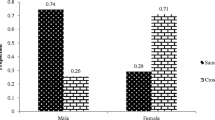Abstract
Gender role identity is acquired through exposure to societal expectations and beliefs about behaviors and characteristics appropriate for males and females. This study examined influences on gender identity among ninety-six Muslim adolescent girls living in the U.S. and attending an Islamic high school. Over three-quarters of the sample characterized themselves as Middle-Eastern or Arab-American. Participants completed a survey in English or Arabic containing background questions, the Bern Sex Role Inventory (Bern, 1974), the Multigroup Ethnic Identity Measure (Phinney, 1992), and a religiosity scale. These young women had comparable femininity scores, but higher masculinity scores than Bern's normative female samples. Results also indicated that those girls who had lived in the U.S. for longer periods reported more masculine attributes. Greater sense of belonging to one's ethnic group and greater religiosity were associated with greater femininity. Thus, identification with one's own culture, adherence to religious practices, and exposure to foreign cultural values were related to gender role identity.
Similar content being viewed by others
References
Abdalla, S.E. and Gibson, J.T. (1984). The relationship of exposure to American culture on the attitude of Libyan nationals toward the role of women in the work force. Contemporary Educational Psychology, 9, 294–302.
Alireza, M. (Oct 1987). Women of Saudi Arabia. National Geographic, 72, 422–453.
Ballard-Reisch, D. and Elton, M. (1992). Gender orientation and the Bern Sex Role Inventory: A psychological construct revisited. Sex Roles, 27, 291–306.
Bern, S.L. (1981). Gender schema theory: A cognitive account of sex typing. Psychological Review, 88, 354–364.
Bern, S.L. (1974). The measurement of psychological androgyny. Journal of Consulting and Clinical Psychology, 42, 155–162.
Dainji, T. and Lee, C.M. (1995). Gender role identity and perceptions of Ismaili Muslim men and women. The Journal of Social Psychology, 135, 215–223.
De Vita, E. and Haverkamp, B. (1997). Assessing the generalizability of the Bern Sex Role Inventory (BSRI): A replication of the BSRI's item selection procedures. Poster presented to the Annual Convention of the A.P.A., Chicago, August.
Harris, A.C. (1994). Ethnicity as a determinant of sex role identity: A replication study of item selection for the Bern, Sex Role Inventory. Sex Roles, 31, 241–273.
Maznah, I. and Choo, P.F. (1986). The factor structure of the BSRI. International Journal of Psychology, 27, 31–41.
Minces, J. (1982). The House of Obedience. France: Zed Press.
Muhsin, A.W. (1992). Qur'an and Women. Penerbit Fajar Bakti.
Phinney, S. (1992). The Multigroup Ethnic Identity Measure. Journal of Adolescent Research, 7, 156–176.
Spence, J.T. and Helmreich, R.L. (1980). Masculine instrumentality and feminine expressiveness: Their relationships with sex-role attitudes and behaviors. Psychology of Women Quarterly, 5,147–163.
Author information
Authors and Affiliations
Rights and permissions
About this article
Cite this article
Abu-Ali, A., Reisen, C.A. Gender role identity among adolescent Muslim girls living in the U.S.. Curr Psychol 18, 185–192 (1999). https://doi.org/10.1007/s12144-999-1027-x
Accepted:
Issue Date:
DOI: https://doi.org/10.1007/s12144-999-1027-x




